Blood: Life-Giving Fluid
Crucial Functions of Blood
Blood is a liquid that is created to give our bodies life. As long as it circulates within the body, it warms, cools, feeds and protects by cleansing the body of toxic substances. It is almost solely responsible for communication within our bodies. In addition, it immediately repairs any fractures in the walls of veins and so the system is rejuvenated.
"We created you so
why do you not confirm the truth?"
(Surat al-Waqi'ah: 57)

On average, there is 1.32 gallons (5 litres) of blood in the body of a human weighing 132 pounds (60 kilograms). The heart can make this amount of blood circulate in the body easily within a minute. However, while running or exercising, this rate of circulation can increase to five times as high. Blood flows everywhere: from the roots of the hair to the toes, inside veins of varying sizes. The veins have been created of such a flawless structure that no clogging or sediments are formed. A variety of nutrients and heat are carried through this complex system.
Oxygen Carrier
The air that we breathe is the most crucial substance for our survival. The oxygen is as necessary for the cells' burning of sugars in energy production as it is for setting a log on fire. This is why oxygen has to be carried from the lungs to the cells. The blood circulatory system, resembling a complicated network of pipelines, serves this very purpose.
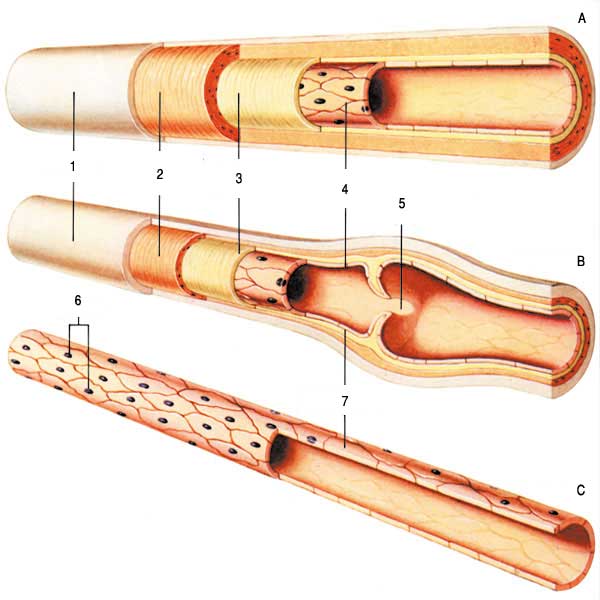
A. Artery
B. Vein
C. Capillary
1. Outer Layer
2a. Thick Smooth Muscle Middle Layer
2b. Thin Smooth Muscle
3. Elastic White Fibrous Tissue
4. İnner Lining (Endothelial Cells)
5. Valve
6. Nuclei
7. Single Layer Of Endothelial Cells
The longest arteries have been created to have the strongest structure since they are responsible for delivering the blood rich in oxygen and nutrients to all corners of the body. Veins are responsible for carrying blood from the organs of the body to the heart. Capillaries, on the other hand, have a perfect design as they distribute the blood to the remotest places.
Haemoglobin molecules inside the red blood cells carry the oxygen. Each one of the disk-shaped red blood cells carries about three hundred million haemoglobin molecules. The red blood cells display a flawless working order. They not only carry the oxygen, but also release it wherever it is necessary, e.g. in a working muscle cell. Red blood cells deliver oxygen to tissues, carry the carbon dioxide, which is produced after the burning of sugar, back to the lungs and then leave it there. Following this, they again bind to oxygen and take it to the tissues.

If it were not for the heart, blood would have been a stale, thick red fluid (above). However, the heart pumps blood into the remotest portions of the body (left).
A Pressure Balanced Fluid
Haemoglobin molecules also carry nitrogen monoxide (NO) gas in addition to oxygen. If this gas were not present in blood, its pressure would change constantly. Haemoglobin also regulates the amount of oxygen to be delivered to tissues by means of nitrogen monoxide. Amazingly, the source of this 'regulation" is nothing but a molecule, i.e. a mere collection of atoms that does not have a brain, eyes or conscious mind. Regulation of our bodies by a collection of atoms, of course, is a sign of the infinite wisdom of Allah Who created our bodies without flaws.
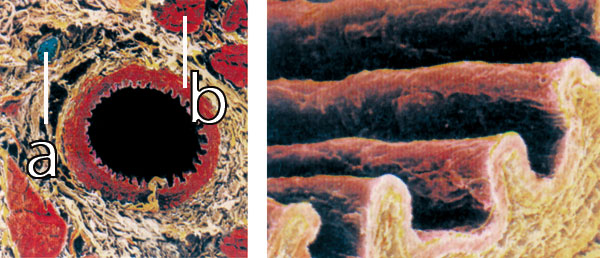
A layer of special muscle tissue wraps the blood vessels. When the muscle contracts, the vessel becomes narrower and increases the blood pressure. The picture to the right is a section of a narrowed vessel. This is why the interior of the vessel is corrugated (above). Around the vessel, there are muscle tendons (red) and a nerve (blue).
a. Nerve, b. Muscle
Cells of Ideal Design
Red blood cells make up the majority of all blood cells. An adult male blood contains thirty billion red cells, which would be enough to cover almost half the surface of a soccer field. These cells give colour to our blood and therefore to our skin.
Red cells look like discs. Due to their incredible flexibility, they can squeeze through capillaries and the minutest holes. If they were not so flexible, they would surely be stuck in various areas of the body. A capillary is normally four to five micrometres in diametre, whereas a red cell is about 7.5 micrometres (one micrometre is one thousandth of a millimetre, which is 0.000039 inch).
What would happen if red cells were not created with such flexibility? The researchers of diabetes gave some answers to this question. In diabetic patients, red blood cells loose their flexibility. This situation frequently gives way to clogging with inflexible red blood cells in the delicate tissues of the patients' eyes, which can lead to blindness.
Automatic Emergency System
The lifespan of a red blood cell is about 120 days after which they are removed by the spleen. This loss is balanced by the continuous production of new cells. Under normal conditions, 2.5 million red blood cells are generated per second, a number which can be increased if necessary. A hormone called 'erythropoietin" regulates the rate of generation. For example, as a result of heavy bleeding due to accident or nose bleeds, the loss is immediately balanced. In addition, the rate of generation is increased if the oxygen content of the air is reduced. For instance, while climbing at very high altitudes, due to the continuously declining oxygen content, the body automatically takes this action in order to make the most efficient use of the oxygen available.
Perfect Transportation System
| 1. Carotid Artery
The circulatory system feeds each one of the hundred trillion cells that constitute the human body. In the figure, the red vessels represent oxygenated blood and the blue depict the deoxygenated blood. | 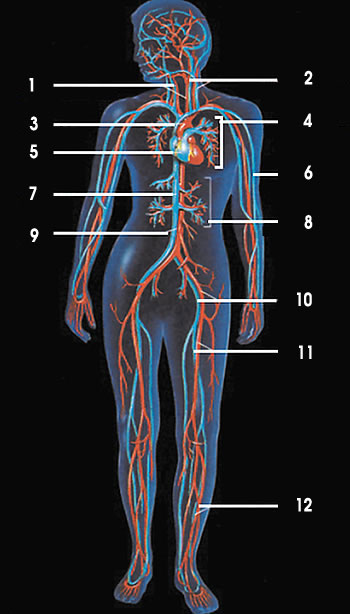 |
The fluid portion of blood called plasma carries numerous other substances present in the body apart from just blood cells. Plasma is a clear yellowish fluid, which comprises 5% of the normal body weight. In this fluid, 90% of which is water, salts, minerals, carbo-hydrates, fats and hundreds of different types of proteins are suspended. Some of the proteins in the blood are transport proteins, which bind lipids and carry them to tissues. If the proteins did not in this way carry the lipids, the lipids would randomly float anywhere, giving way to fatal health problems.
Hormones in the plasma take on the role of special couriers. They facilitate com-munication between organs and cells by means of chemical messages.
Albumin is the most populous hormone in the plasma, which is in a sense a transporter. It binds lipids such as cholesterol, hormones, billirubin, a toxic yellow bile pigment, or medicines like penicilin. It leaves the poisonous substances in the liver and takes other nutrients and hormones to wherever they are needed.
When all these things are considered, it becomes clear that the body is created in an extremely detailed way. The abilities of a single protein to distinguish between lipid, hormone and medicine, and to determine not only the locations in need of them but also the amounts to be delivered, are all indications of flawless design. Furthermore, these surprising examples are only few out of dozens of thousands of different biochemical events taking place in a body. All of the trillions of molecules in the body work in a marvellous harmony. And, in fact, all of these molecules spring from the division of a single cell that forms in the womb of a mother. It is clear that this miraculous system of the human body is a wonderful artistry of Allah, Who created man from a single drop of water.
Special Control Mechanisms
Nutrients have to cross from the arteries through the artery wall, in order to penetrate into the necessary tissues. Although the artery wall has very small pores, no substance can penetrate it by itself. It is the blood pressure that facilitates this penetration. However, nutrients crossing over into the tissues in larger quantities than necessary causes inflammation in the tissues. Therefore, there is a special mechanism instituted for balancing blood pressure and withdrawing fluid back to the blood. This is the responsibility of albumin, which is larger than the pores in the artery wall and numerous enough in the blood to suck up the water like a sponge. If there were no albumin in the body, it would swell like a dry bean left in water.
On the contrary, materials in the blood should not enter the tissues of the brain uncontrolled, since unwanted substances can severely damage nerve cells (neurons). Therefore, the brain is protected against all possible scenarios of harm. Dense cell layers close off pores. All substances are required to pass through these layers as if passing through a security checkpoint, which facilitates a balanced flow of nutrients into the most sensitive organ of the whole body.
Thermostat in the Body
Apart from toxins, red blood cells, vitamins and other substances, blood also carries heat, a by-product of energy generation in the cells. Distributing and balancing body heat in accordance with the outside temperature is vitally important. If there were no heat distribution system in our bodies, our arms would overheat and the rest of the body would be cool when the arm muscles are used, which would greatly damage the metabolism. This is why heat is evenly distributed throughout the body, which is facilitated solely by the circulatory system. In decreasing the body-heat that is distributed all over the body, the perspiration system is activated. In addition, blood vessels enlarge under the skin, enabling excess heat in the blood to be transmitted to the outside air. This is why when we run or do other high-energy activities, our faces become red. Blood circulation is as responsible in preservation of the body heat as in cooling. In colder temperatures, the blood vessels under our skin shrink, which serves to reduce the amount of blood in the area where heat escape is most probable and hence to keep cooling to a minimum. The reason for a person's face turning white when cold is the precaution that the body automatically takes.42

If a blood clot (above) forms in the coronary veins of the heart and continues to enlarge, it leads to a heart attack. In some situations due to blood pressure, heart tissue is ruptured. Blood gushes out of the heart as if spraying from a hose (below).
Everything taking place in the blood is extremely complicated and intertwined. Everything has been created flawlessly down to the smallest detail. In fact, there is such a wonderfully intricate balance in the bloodstream that the smallest breakdown could potentially cause very serious complications. Blood has been created with all its necessary properties by the One Creator in a moment. This Creator, the owner of superior knowledge and power, is Allah:
Your god is Allah alone, there is no god but Him. He encompasses all things in His knowledge. (Surah Ta Ha:98)
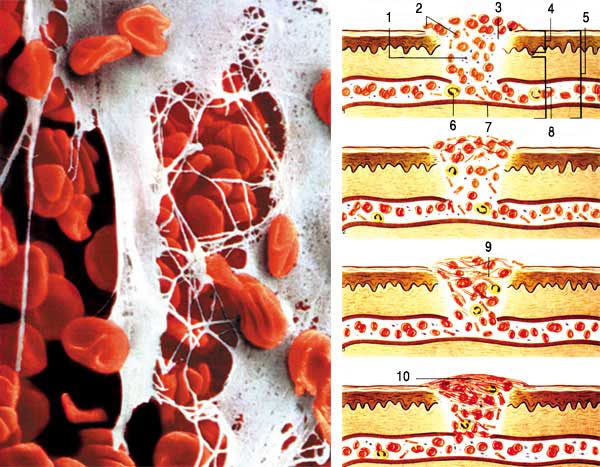
1. Platelets
2. Red Blood Cells
3. Plasma
4. Epidermis
5. Skin
6. White Blood Cells
7. Blood Vessels
8. Dermis
9. Fibrin Threads
10. Cornifled Layer (Scab)
The Blood Clotting Mechanism: When a wound starts bleeding on our bodies, an enzyme called thromboplastin that is released from damaged tissue cells combines with the calcium and prothrombin in the blood. As a result of the chemical reaction, the resulting mesh of threads form a protective layer, which solidifies eventually. The top layer of cells eventually die, becoming cornified, so forming the scab. Underneath the scab, or protective layer, new cells are being formed. When damaged cells are completely replaced, the scab drops off.
A System Without Room for Smallest Error: Blood Clotting
Everybody knows that bleeding will eventually stop when there is a cut or when an old wound starts bleeding again. Where the bleeding is, a blood clot forms that hardens and heals the wound in due time. This may be a simple and normal phenomenon for you, but biochemists have shown through their research that this actually is the result of a very complicated system at work. The lack of any one component of this system or any damage to it would render the whole process useless.
Blood has to coagulate in the right time and place and when normal conditions are restored, the clot should vanish. The system functions flawlessly down to the minutest detail.
If there is bleeding, the clot should form immediately in order to prevent the creature from dying. Furthermore, the clot should cover the entire wound and, more importantly, should only form over, and remain right on top of, the wound. Otherwise all the blood of the creature could coagulate and cause its death, which is why the clot should form at the right time at the right place.
The smallest elements of the bone marrow, the blood platelets or thrombocytes, are crucial. These cells are the main elements behind the coagulation of blood. A protein, called the Von Willebrand factor, ensures that, in their continuous patrol of the blood stream, these platelets do not miss the place of the injury. The platelets that become entangled in the location of the injury release a substance that collects countless others to the same place. These cells eventually shore up the open wound. The platelets die after performing their duty in locating the wound. Their sacrifice is only a part of the coagulation system in the blood.
Thrombin is another protein that facilitates coagulation of blood. This substance is produced only at the location of the wound. This production must be neither more nor less than necessary, and has also to start and stop exactly at the required times. There are more than twenty body chemicals called enzymes that have roles in the production of thrombin. These enzymes can trigger its reproduction or halt it. The process is under so much scrutiny that thrombin only forms when there is a real wound to the tissues. As soon as the enzymes of coagulation reach a satisfactory level in the body, fibrinogens that are composed of proteins are formed. In a very short while, a mesh of fibres form a web, which is formed at the location of the escaping blood. In the meantime, patrolling platelets continue to become entangled and accumulate at the same location. What is called a clot is the plug that is formed due to this accumulation.
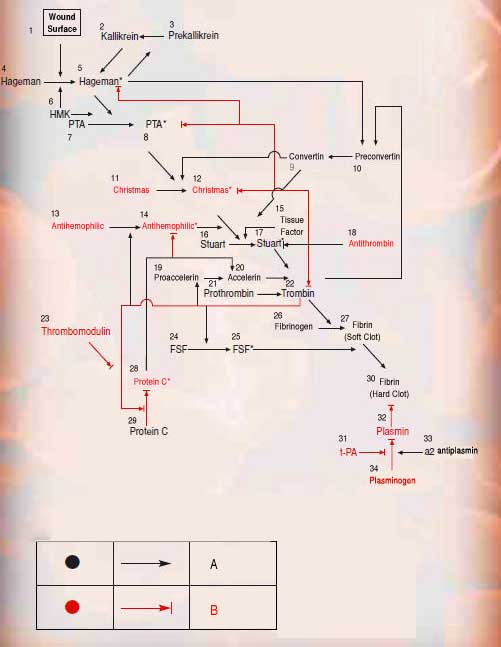
The Blood Coagulation Mechanism
The figure below44 illustrates the coagulation mechanism of the blood. The clot is generated as a result of the chemical reactions of a series of substances in a certain order. For dissolution of the clot, a similarly complicated process takes place.
A. Proteins that are involved in promoting clot formation
B. Proteins that are involved in the prevention, localization, or removal of blood clots.
1. Wound Surface
2. Kallikrein
3. Prekallikrein
4. Hageman
5. Hageman*
6. HMK
7. PTA
8. PTA*
9. Convertin
10. Preconvertin
11. Christmas
12. Christmas*
13. Antihemophilic
14. Antihemophilic*
15. Tissue Factor
16. Stuart
17. Stuart*
18. Antithrombin
19. Proaccelerin
20. Accelerin
21. Prothrombin
22. Thrombin
23. Trombomodulin
24. FSF
25. FSF*
26. Fibrinogen
27. Fibrin (Soft Clot)
28. Protein C*
29. Protein C
30. Fibrin (Hard Clot)
31. t-PA
32. Plasmin
33. a2-Antiplasmin
34. Plasminogen
When the wound totally heals, the clot dissolves.
The system that enables formation of the clot, determining its extent, strengthening or dissolving the formed clot undoubtedly, has an absolute irreducible complexity.43
The system works flawlessly down to the minutest detail.
What would happen if there were small problems within this perfectly functioning system? For example, if there was coagulation in the blood even without a wound, or if the clot could easily break off from the wound? There is a single answer to these questions: in such cases the bloodstream to the most vital and intricate organs, such as heart, brain and lungs, would be clogged with clots, which would inevitably bring death.
In reality, this shows us one more time that the human body is flawlessly designed. It is impossible to explain the clotting system of the blood through the hypothesis of coincidence or "gradual development" as asserted by the theory of evolution. Such a carefully engineered and calculated system as this is indisputable evidence of the perfection in creation. Allah, Who created us and placed us on this earth, has created our bodies with this system, which protects us in many cases of injury that we encounter throughout our lives.
The clotting of blood is very important not only for visible injuries but also for the ruptures of capillaries in our bodies that happen all the time. Although unnoticed, there are continuously small internal bleedings. When hitting an arm against a door or sitting down too heavily, hundreds of capillaries are ruptured. These bleedings are immediately stopped by means of the clotting system and the capillaries are reconstructed in their normal condition. If the impact is more serious, then the internal bleeding is stronger, giving way to the bruising commonly termed "turning purple". A human lacking the coagulation system would have to avoid even the smallest impacts. Haemophilic patients, having defective coagulation systems, live their lives like that. Patients with advanced haemophilia unfortunately do not survive too long. Even small internal bleedings, inflicted by a simple slip and fall, could be enough to end their lives. Due to this simple reality, each individual should consider the miracle of creation within his/her own body and be thankful to Allah, Who created that body flawlessly. This body is a blessing to us from Allah, a single cell of which we cannot even reproduce. When addressing mankind, Allah says:
"We created you, so why do you not confirm the truth?" (Surat al-Waqi'a: 57)
